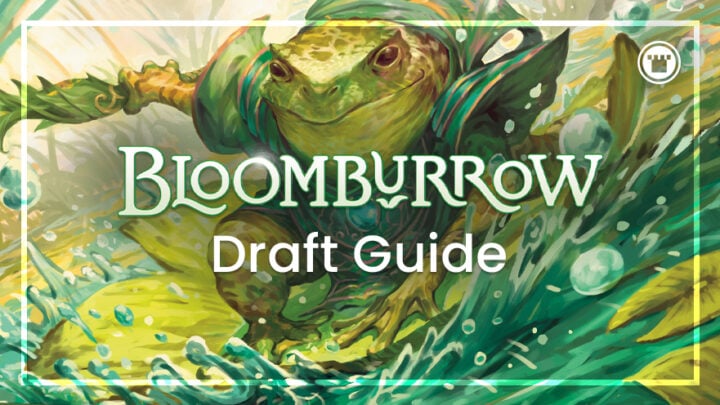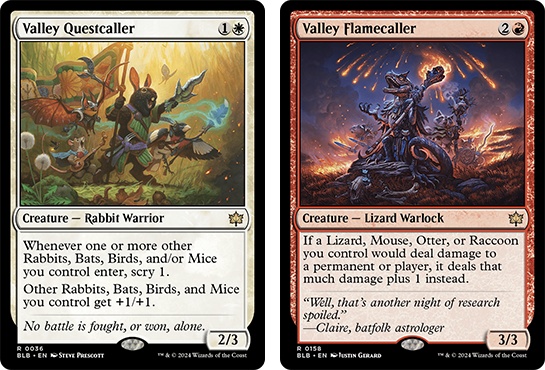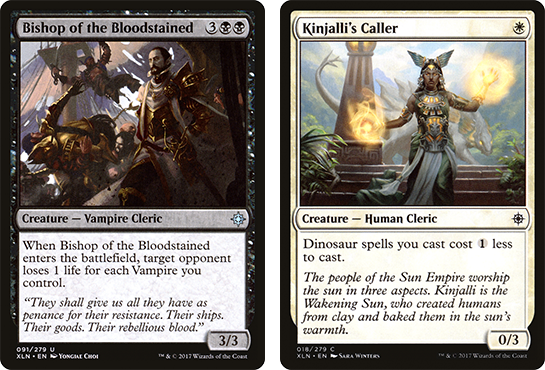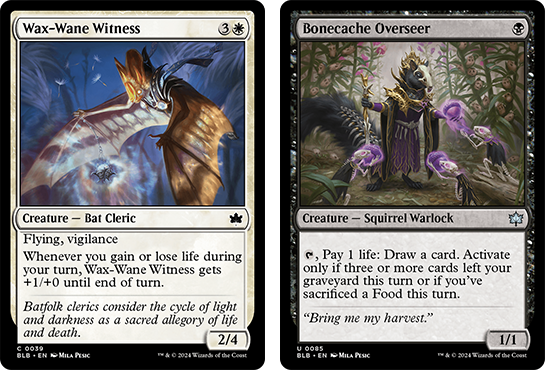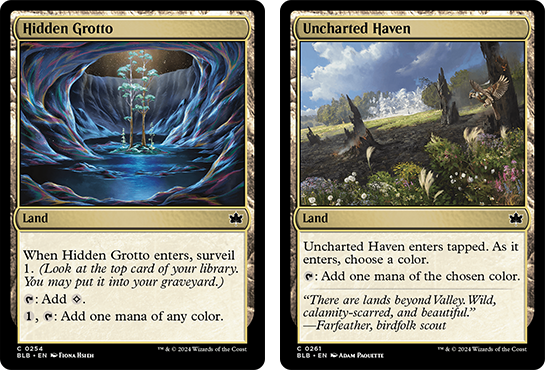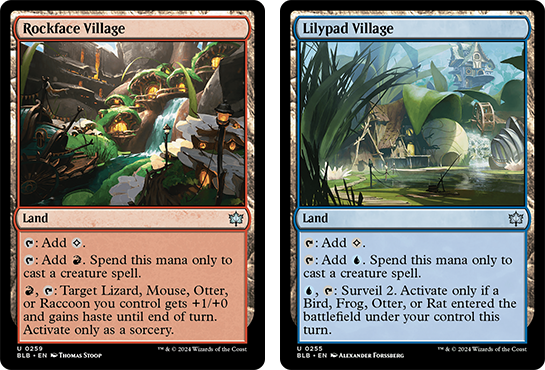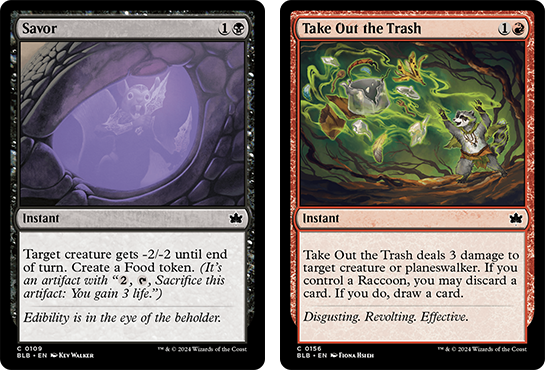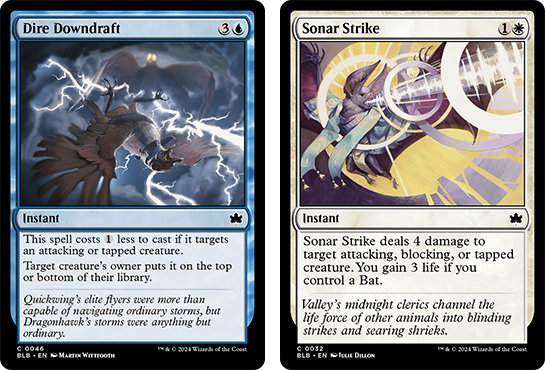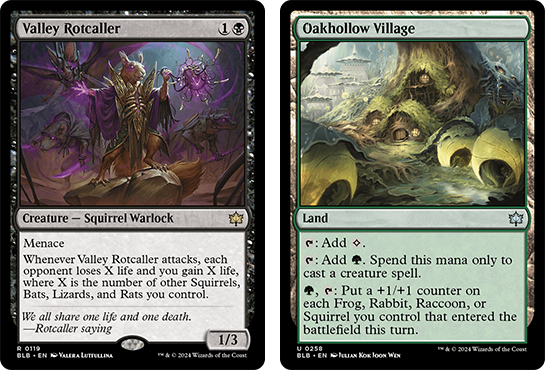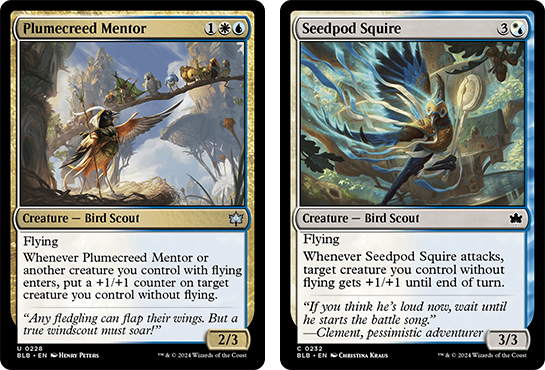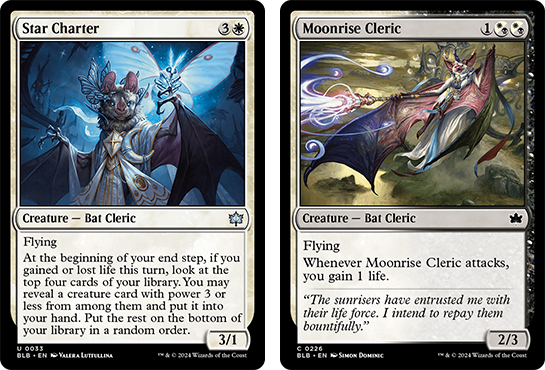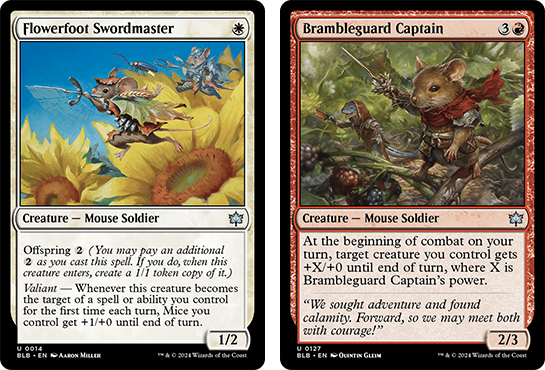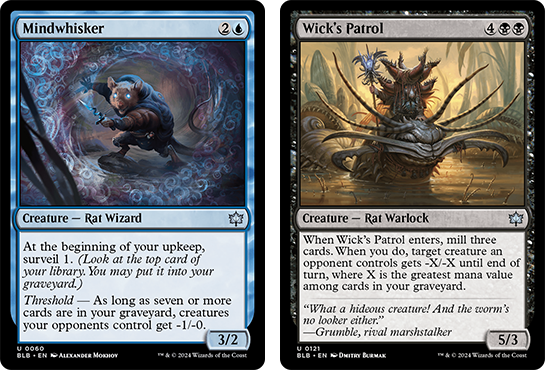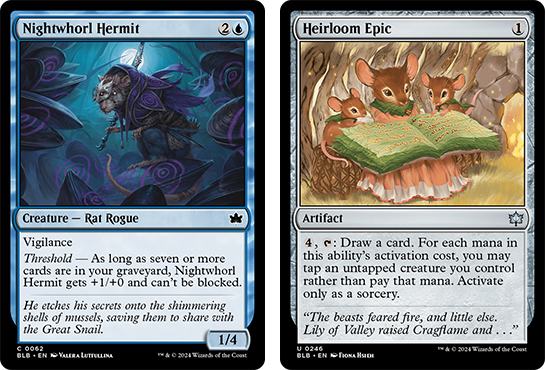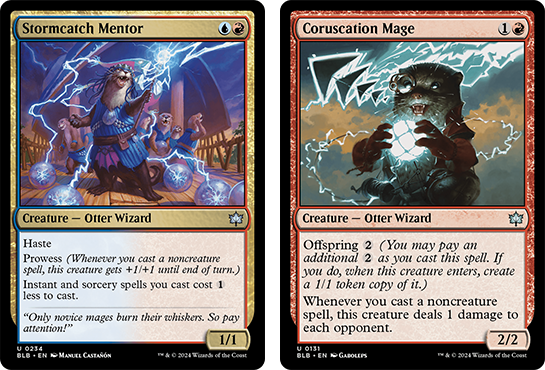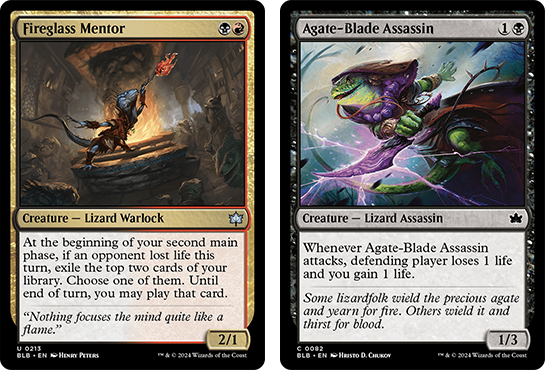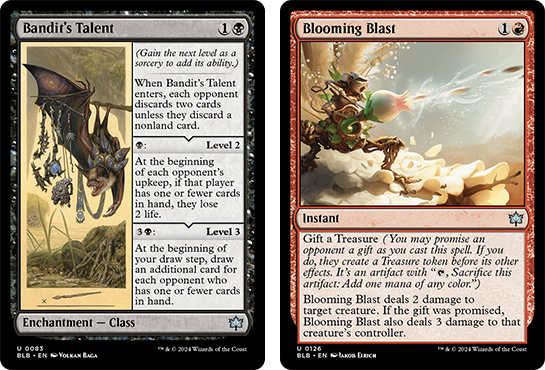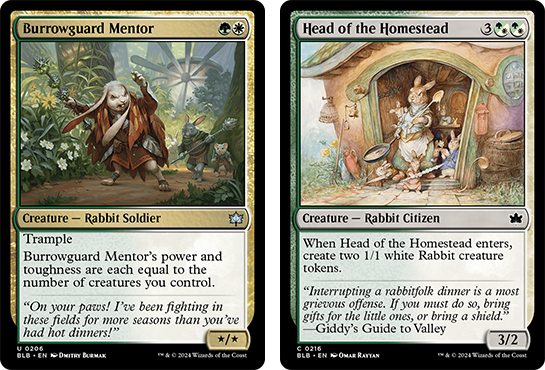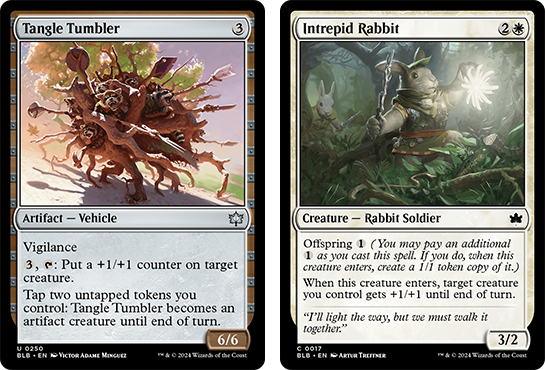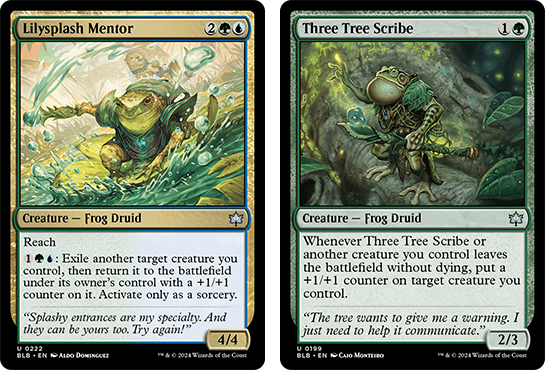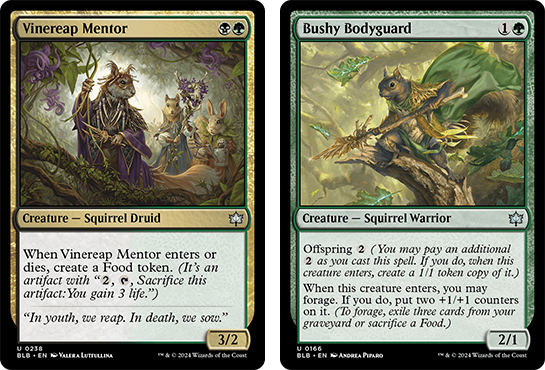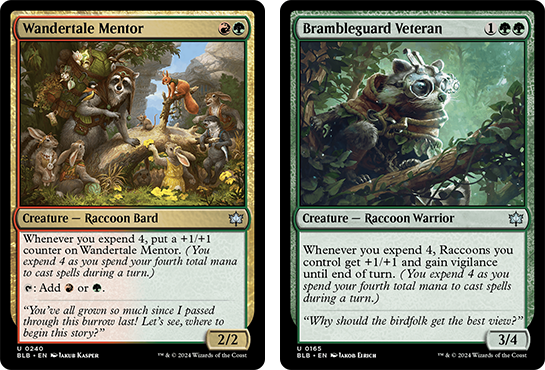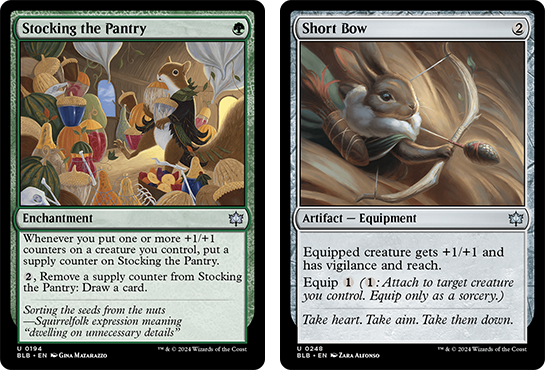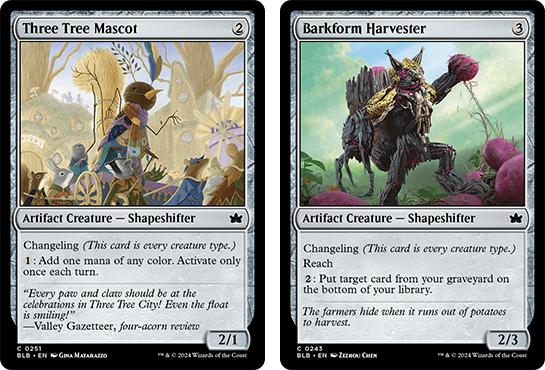Bloomburrow was one of the most hotly-anticipated sets I can remember from the very first announcement, and the product itself hasn’t disappointed. The fuzzy critters who inhabit the land known as Valley are cute – but not always so cuddly! This set has fierce field mice and resolute rabbits dicing it up with spooky squirrels and rowdy raccoons, and that’s not even half the animal factions involved in this melee.
Perhaps due to that variety, the typal themes in this set aren’t as prominent as I expected going in. Instead, Bloomburrow kind of takes us back to a fundamental Draft experience – albeit with some very powerful synergies which place those woodland creatures at the heart of every strategy.
Read on for our full breakdown of Bloomburrow Draft and all 10 of its furred and feathered archetypes!
SHAPE OF THE FORMAT
I would describe Bloomburrow Limited as being creature centric with “soft” typal themes.
Past sets like the original Ixalan employed very direct and explicit typal mechanics to define their archetypes. There’s little room for improvisation when it comes to which cards work well together: you’re not playing Kinjalli’s Caller and Imperial Lancer in the WB Vampires deck, and you wouldn’t pick Bishop of the Bloodstained if you were playing BR Pirates.
Bloomburrow still has a handful of these strict typal enablers in each color, but many of its designs substitute the mention of their specific creature type for that type’s signature chosen mechanic. So rather than caring if a bat entered play under your control, a lot of WB cards trigger when you’ve gained or lost life during the current turn – something the bats are great enablers of. But if you happen to be in a Wx or xB deck that’s short on bats, you still have the chance to turn on those cards by eating a Food token, or by attacking with a lifelinker, or casting a black draw spell.
The same Food will also help enable the Forage ability of Squirrels in black, or the token synergies of Rabbits in white. This overlap is what makes each color in Bloomburrow feel coherent despite effectively being four different typal decks in a trenchcoat! It’s a remarkable balancing act from the design team, especially when you consider each creature type has to fit in with two different sets of allies across its color pair.
Multi-Color Support
Two-color decks are definitely the order of the day, as Bloomburrow Limited has maybe the weakest color fixing of any recent set. Three Tree Rootweaver is the only non-rare fixer you’re always happy to draft. You can usually sneak the first Patchwork Banner or Fountainport Bell or Three Tree Mascot into most decks and have them be passable. But Heaped Harvest has looked very disappointing unless you can use it to fuel forage effects.
And that’s it – there’s no common land-cyclers and only the weakest rainbow non-basic lands to help smooth your mana out. In fact, Bloomburrow’s other non-basic lands actually push you AWAY from multi-color drafting: they can’t pay colored costs for noncreature spells or abilities, they have colored activation costs themselves, and they only interact with creature types associated with their color.
Even with some strategically-placed hybrid mana symbols making spells more forgiving to cast, non-green decks are really pushing their luck to splash anything beyond a single off-color bomb, since even drawing a fixing land early can be enough to disrupt your curve.
Pace of Play
The removal in Bloomburrow is, again, mostly on the weaker side, contributing to the creatures-first identity of the set. But any interaction at three mana or less is going to be worth it to bail you out against a nasty opening on the draw.
Savor, Nocturnal Hunger, Take Out the Trash, Agate Assault, Sonar Strike and Banishing Light are all top commons in their color. The green and blue removal spells are a noticeable step down, but still essential if you can’t find a better set of answers. Ironically, the lower quality removal does make playing combat tricks on defense a bit less terrifying, so Crumb and Get It or High Stride can fill this role in a pinch.
Having a lot of solidly-statted blockers at two and three mana is the second key to surviving Bloomburrow (as it is in every set). But it’s not a good substitute for actual removal. There’s too many value engines, flying decks and blowout opportunities for attackers – all things you really need to respond to with targeted interaction. If you can’t get your hands on any through the draft, you had better try and seize the initiative and put pressure on your opponent’s life total every chance you get, so at least the combat happens on your terms.
ARCHETYPE BREAKDOWN
Each of the ten two-color pairs is associated with a specific creature type. However, since Bloomburrow is almost all single-color cards, this really means that each color pair is a mix of seven possible creature types, with the main one appearing across both your colors.
So a GB deck may not actually have a lot of squirrel synergies, or even play squirrels at all. But it is a lot more likely to have squirrels than not, and the signature mechanics of squirrels are going to be the easiest to set up and pay off in GB compared to other Gx or Bx decks. So keep in mind that the advice given for rats in the UB archetype will also be relevant when drafting rat cards for your UG or BR decks!
WU: Birds – Flying Midrange
First of all, I need to make it clear that the definition of “control” vs. “midrange” archetypes for Bloomburrow is even less clear than in most Limited environments. There just aren’t as many cards which encourage a reactive playstyle. Even in UW where there’s enough of them to make a control deck work, your actual bird creatures are designed much more aggressively, sporting on-attack triggers and other stat-pumping effects.
The bird mechanic puts an intriguing twist on classic UW flyer decks – most birds specifically provide buffs to non-flying creatures. Combined with the fact most birds cost upwards of three mana, it’s clearly intended that your “bird” deck feature a significant ground army of rabbits, stoats and mice (especially mice – see the WR section) which can then curve into those buff-granting flyers to finish games.
The biggest flex point for bird decks is going to be their preferred pace of play: if you end up with tons of white removal, you could simply treat those ground creatures as a wall and wait for your birds to do 20 damage in the air.
WB: Bats – Lifegain Control
Flyers in general feel very strong in Bloomburrow, and with cheaper mana costs than the birds and a lot of lifegain to help race, bat decks should definitely be able to play proactively. But the natural strength of WB is in its removal – by far the best in the set. So the bat air force ends up as more of a steady clock that grinds down opposing life totals while your interaction grinds away at their other resources.
All that lifegain and removal is extremely important to your success, because bats really do not like to block! Their stats are bad for their cost, and their effects take time to accrue full value – whether that’s the trickle of lifegain of Lifecreed Duo and Moonrise Cleric, or per-turn card advantage from Star Charter and Starseer Mentor.
As with the birds, the intent seems to be that you draft some stoic rats or rabbits to do the blocking – this kind of interdependency between types is something you’ll have to get used to across Bloomburrow Draft.
WR: Mice – Valiant Aggro
In a set where every color combination can arguably beat down, WR is maybe the most unequivocally aggressive deck you can draft. Its main creature type, mice, have a tweaked version of the valiant mechanic which triggers when you target them with spells OR abilities.
That “or” is absolutely massive, allowing you to regularly and easily trigger these valuable abilities without needing to draft and play a lot of combat tricks. All you need are creatures which consistently generate targeting triggers on their own: Roughshod Duo, Brambleguard Captain, Thistledown Players, Seedpod Squire, and so on.
There’s enough of both enablers and payoffs within the WR card pool that these decks feel extremely consistent and powerful – basically impossible to block against. This is the biggest source of those “early-removal check” scenarios I described above – if you can’t break up their momentum with a Savor or Polliwallop, you just have to hope they hit a string of dead draws.
For the RW player’s part, the hardest thing may be finding the right balance of creatures against combat tricks and removal – even if you can enable your valiant mice with just other creature cards, it’s still important to have a few instants up your sleeve for when your opponent is finally forced to make some blocks.
UB: Rats – Threshold Control
Poetic somehow that Bloomburrow’s rats and mice should be opposites in practically every way. Where the mice are fast, proactive, and reliant on assembling synergistic combos to bring out the most from their cards, rats are defensive, controlling and get more powerful from just playing solid Magic and drawing out the game regardless of what cards you use to do it.
This is best embodied by their threshold ability and toughness-focused statlines. Even the rats which look aggressive, like Persistent Marshstalker, have abilities which compliment a slow, grinding playstyle. Rats are built to chip away and increase their lead gradually, whether that’s a life lead through Sinister Monolith and Nightwhorl Hermit, or a card advantage from Shoreline Looter and Heirloom Epic.
As with all blue decks in this format, extra care must be taken to make sure you have enough cheap stats or removal to slow down aggro – although the high-toughness blue rats do make this easier. So long as you can reach the point where Mindwhisker or Bandit’s Talent start kicking in, you should be set to sloooowly lock up the win.
UR: Otters – Spellslinger Tempo
As with birds and bats, Otters are a little tricky to place on the aggro-control spectrum. On the one hand, UR prowess themes almost always forces you towards an aggressive, tempo-pushing draft archetype. But on the other hand, the actual stats on these creatures are TERRIBLE – two-mana 1/1s, three-mana 2/2s, a four-mana 4/2.
Having prowess or built-in card advantage can make up for those flaws when you’re the one dictating the pace… but how can you expect to do that when the gap between your turn three board and your opponents is so massive? The fact that Bloomburrow has fewer instants than you might like also really hampers the effectiveness of prowess on opposing turns, deepening those defensive woes.
So, does all that mean UR decks are a bad idea in Bloomburrow Draft? Actually, no! But you should definitely take your focus off the otter cards and prioritize drafting all the interaction you can first. I’d rather be casting Pearl of Wisdom for three mana than try and block a mouse or raccoon deck on the draw with just an Otterball Antics token.
BR: Lizards – Bloodthirst Aggro
Ahh, good old BR aggro. Once again these colors come together to play the fastest possible game, trying to spend all your cards and life to run the opponent out of their resources slightly faster. This elegant simplicity is helped by lizards having the least going on mechanically of any creature type in Bloomburrow – their mechanic just rewards you for dealing consistent damage to your opponent every turn before casting your spells.
This means you want to start attacking early and then keep the number of cards in play low, which keeps your menace creatures relevant and buys more time for your indirect damage sources to slowly whittle opponents down.
Obviously grabbing as much removal and discard as you can manage helps here. But if you can’t put together a fully convincing aggro deck, then falling back on flyers and pingers while your other bodies block it out can still win a lot of games.
WG: Rabbits – Token Aggro
The rabbits are a bit like the lizards in that their typal mechanics don’t really warp your gameplan away from the norm for GW Limited decks. But the bunnies are definitely better off in terms of raw power level on those mechanics, and on a lot of their other cards. The suite of commons in particular are just amazing for what GW wants to do: Warren Elder, Intrepid Rabbit, Druid of the Spade and Treeguard Duo can generate enough stats at high efficiency to challenge a lot of draws by themselves.
Then you start adding in white’s plentiful removal, strong synergies with frogs and birds, and the scaling threat of go-wide payoffs like Rabbit Response as the game drags on, and it feels as though there are relatively few weak points for this archetype.
The challenge I see is more in assembling it: those commons are definitely strong, but only Intrepid Rabbit actually helps the game plan of generating additional bodies, and other cards which make tokens or help you draw more creature cards are a lot harder to come by. Even if you get those but miss on say, removal, the slow and predictable GW buildup can be your undoing when you can’t disrupt key pieces from a superior frog or bat value engine.
UG: Frogs – Flicker Control
UG seems to be the most popular deck in the first week of Bloomburrow draft, and it’s easy to understand why. It has a novel playstyle that I’ve never seen supported this well in Limited before, AND that playstyle is extremely strong! The various frog creatures all play around the idea of “hopping” in and out of play, triggering both ETBs on that creature and many secondary effects on your support cards.
The exact mechanism of the “hopping” varies, with weaker cards simply bouncing the creature to hand to be re-cast, and stronger options exiling and re-entering them immediately at no further mana cost. You can get the value-ball rolling with Sunshower Druid, Pond Prophet and Stickytongue Sentinel, but the real prizes are uncommons like Three Tree Scribe and especially Lilysplash Mentor, which feels borderline unbeatable if not removed.
My opponent here only drew one forest but still managed to cast Sunshower Druid at least 25 times.
You ideally want to fit in some Polliwallop or other interaction to neutralize any serious threats while you slowly build a board, but the ETB bonuses can add up to stabilize you on their own surprisingly fast! Also, since frogs are in green and happy to play a slower game by default, this is one of the best decks to leverage a splash or even a full third color – the big reward being even nastier ETB effects you can hop in and out of play.
BG: Squirrels – Graveyard Midrange
Another archetype which offers a fun twist on familiar mechanics, squirrels are the resident graveyard enjoyers of Valley. But there’s a lot less emphasis than you might expect on recurring and reanimating big creatures from the grave; instead, the squirrels mostly just want cards in the graveyard in bulk so they can be “foraged” into exile to fuel effects.
I like the flavor quite a lot here, but unfortunately I find the squirrels severely undercooked compared to other decks in Bloomburrow. One issue is that they split their focus between these graveyard mechanics and food tokens, which are only related to each other through the handful of cards with forage abilities.
More damaging is the weird scarcity of mill effects, especially considering that forage costs three cards a pop. Your options for filling the yard are expensive, fail to impact the board, or conditional effects associated with other types like rats and bats. This pushes you to try and trade more aggressively so you can build up the graveyard that way – but then the squirrel creatures have surprisingly poor stats for their mana cost, forcing you to surrender life points and try to set up plausible multi-blocks instead.
I’m sure that an ideal squirrel deck which has multiple copies of its mill cards and strong removal can really build an engine to grow its Honored Dreyleaders and Corpseberry Cultivators, but I’m yet to see anything close to that in actual games.
RG: Raccoons – Ramp Midrange
The raccoons are a fitting choice to round out our Bloomburrow archetype discussion, because more than any other I feel like this is the creature type which shows up to round out other decks. That has a lot to do with the flexible conditions of their expend mechanic, which basically amounts to “casting spells makes raccoons bigger”. The other key factor is just their size – as the relative giants of Valley society, raccoons are some of the only “big” creatures in a set where everything else is 3/3 or smaller.
I talked up the aggro power of mice earlier, but curving Bakersbane Duo into Brambleguard Veteran into any four-drop is impossible to contest going first. The fact a deck with natural late-game advantages can frequently end games by turn 5 or 6 is a sign of how nasty raccoons can be, and the raw power of their creature cards means you necessarily need any amount of typal synergy to draft and play them.
The red raccoon cards are a little smaller stats-wise, and so aren’t quite the format all-stars that their green buddies are. But the high-floor, high-ceiling nature of these designs means I’m always happy to snap them up when I don’t have a more obvious choice in the pack.
VALLEY OF PLENTY
I went into this set expecting to be charmed by Bloomburrow’s adorable aesthetic, but I’ve found myself just as enamored by its unique and open-ended approach to typal mechanics. This “soft” typal style is amazing for Limited, because it frees you up to mix all a color’s subthemes together based on what you open more of and what the individual cards do. It’s not necessary to commit to a creature type or even a color super-early and then lock in every pick for the rest of the draft.
I also love how leaving the synergies more open-ended lets players discover their own combos – like using equipment to enable your valiant mice, or triggering your bats by NOT promising a gift with Nocturnal Hunger.
Even the cards which do have strict typal restrictions end up feeling more interesting and flexible because you’re not being forced to do that from pick one of every draft! I wish all of you who read this far the best of luck on your own Valley adventures – and I look forward to seeing your own inventive typal combinations on social media.
BONUS for sticking to the end – Top Common Picks by Color!
White: Sonar Strike, Warren Elder, Banishing Light, Lifecreed Duo, Wax-Wane Witness
Blue: Seedpod Squire, Finch Formation, Dazzling Denial, Waterspout Warden, Shore Up
Black: Nocturnal Hunger, Savor, Daggerfang Duo, Scales of Shale, Starlit Soothsayer
Red: Take Out the Trash, Agate Assault, Roughshod Duo, Sazacap’s Brew, Junkblade Bruiser
Green: Three Tree Rootweaver, Sunshower Druid, Rust-Shield Rampager, Polliwallop, Bakersbane Duo
Colorless: (the two Changeling artifacts are more playable than you think!)

Tom’s fate was sealed in 7th grade when his friend lent him a pile of commons to play Magic. He quickly picked up Boros and Orzhov decks in Ravnica block and has remained a staunch white magician ever since. A fan of all Constructed formats, he enjoys studying the history of the tournament meta. He specializes in midrange decks, especially Death & Taxes and Martyr Proc. One day, he swears he will win an MCQ with Evershrike. Ask him how at @AWanderingBard, or watch him stream Magic at twitch.tv/TheWanderingBard.

